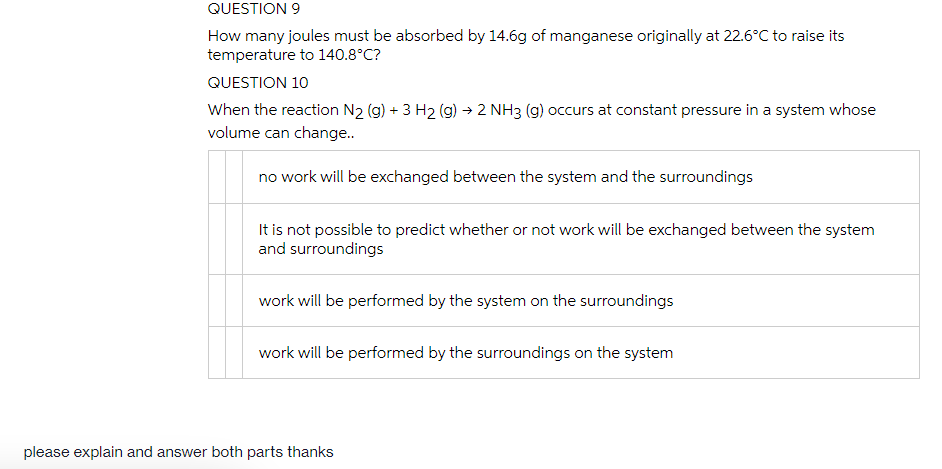QUESTION 9 How many joules must be absorbed by 14.6g of manganese originally at 22.6°C to raise its temperature to 140.8°C? QUESTION 10 When the reaction N2 (g) + 3 H2 (g) → 2 NH3 (g) occurs at constant pressure in a system whose volume can change. no work will be exchanged between the system and the surroundings It is not possible to predict whether or not work will be exchanged between the system and surroundings work will be performed by the system on the surroundings work will be performed by the surroundings on the system
QUESTION 9 How many joules must be absorbed by 14.6g of manganese originally at 22.6°C to raise its temperature to 140.8°C? QUESTION 10 When the reaction N2 (g) + 3 H2 (g) → 2 NH3 (g) occurs at constant pressure in a system whose volume can change. no work will be exchanged between the system and the surroundings It is not possible to predict whether or not work will be exchanged between the system and surroundings work will be performed by the system on the surroundings work will be performed by the surroundings on the system
Chemistry & Chemical Reactivity
10th Edition
ISBN:9781337399074
Author:John C. Kotz, Paul M. Treichel, John Townsend, David Treichel
Publisher:John C. Kotz, Paul M. Treichel, John Townsend, David Treichel
Chapter5: Principles Of Chemical Reactivity: Energy And Chemical Reactions
Section: Chapter Questions
Problem 31PS: A volume of 1.50 L of argon gas is confined in a cylinder with a movable piston under a constant...
Related questions
Question

Transcribed Image Text:QUESTION 9
How many joules must be absorbed by 14.6g of manganese originally at 22.6°C to raise its
temperature to 140.8°C?
QUESTION 10
When the reaction N2 (g) + 3 H2 (g) → 2 NH3 (g) occurs at constant pressure in a system whose
volume can change..
no work will be exchanged between the system and the surroundings
It is not possible to predict whether or not work will be exchanged between the system
and surroundings
work will be performed by the system on the surroundings
work will be performed by the surroundings on the system
please explain and answer both parts thanks
Expert Solution
This question has been solved!
Explore an expertly crafted, step-by-step solution for a thorough understanding of key concepts.
Step by step
Solved in 2 steps with 2 images

Knowledge Booster
Learn more about
Need a deep-dive on the concept behind this application? Look no further. Learn more about this topic, chemistry and related others by exploring similar questions and additional content below.Recommended textbooks for you

Chemistry & Chemical Reactivity
Chemistry
ISBN:
9781337399074
Author:
John C. Kotz, Paul M. Treichel, John Townsend, David Treichel
Publisher:
Cengage Learning

Chemistry & Chemical Reactivity
Chemistry
ISBN:
9781133949640
Author:
John C. Kotz, Paul M. Treichel, John Townsend, David Treichel
Publisher:
Cengage Learning

Chemistry: Principles and Practice
Chemistry
ISBN:
9780534420123
Author:
Daniel L. Reger, Scott R. Goode, David W. Ball, Edward Mercer
Publisher:
Cengage Learning

Chemistry & Chemical Reactivity
Chemistry
ISBN:
9781337399074
Author:
John C. Kotz, Paul M. Treichel, John Townsend, David Treichel
Publisher:
Cengage Learning

Chemistry & Chemical Reactivity
Chemistry
ISBN:
9781133949640
Author:
John C. Kotz, Paul M. Treichel, John Townsend, David Treichel
Publisher:
Cengage Learning

Chemistry: Principles and Practice
Chemistry
ISBN:
9780534420123
Author:
Daniel L. Reger, Scott R. Goode, David W. Ball, Edward Mercer
Publisher:
Cengage Learning

Chemistry by OpenStax (2015-05-04)
Chemistry
ISBN:
9781938168390
Author:
Klaus Theopold, Richard H Langley, Paul Flowers, William R. Robinson, Mark Blaser
Publisher:
OpenStax

Chemistry: Principles and Reactions
Chemistry
ISBN:
9781305079373
Author:
William L. Masterton, Cecile N. Hurley
Publisher:
Cengage Learning

General Chemistry - Standalone book (MindTap Cour…
Chemistry
ISBN:
9781305580343
Author:
Steven D. Gammon, Ebbing, Darrell Ebbing, Steven D., Darrell; Gammon, Darrell Ebbing; Steven D. Gammon, Darrell D.; Gammon, Ebbing; Steven D. Gammon; Darrell
Publisher:
Cengage Learning